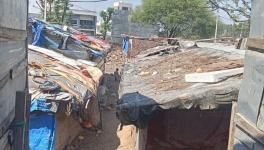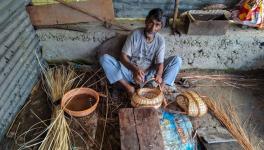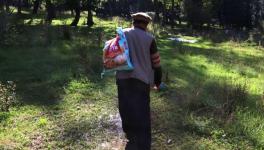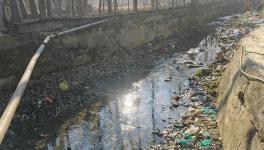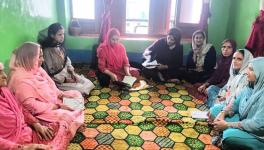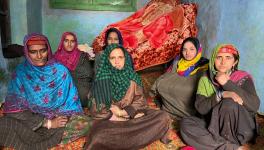Photo Essay: Hydropower Projects in Chenab Valley ‘Ticking Time Bombs’
More than six hydropower projects are under construction on the Chenab, raising concerns over the impact on the ecology and topography of the region.
Around 11 earthquakes have struck Jammu and Kashmir (J&K) in the last 10 days, sending scientists and residents into a tizzy. The residents of Chenab Valley, which is an active seismic zone, are especially worried that the frequent temblors will hot one of the three dams on Chenab river, which would wreak havoc on the region.
Several power plants have been constructed on banks of the Chenab across Kishtwar. Experts have warned of disastrous consequences because of the bumper-to-bumper construction of dams on the river.
Nearly, a dozen hydropower projects have either been constructed or are in various phases of development on the Chenab. Geologists and environmentalists have been sounding the alarm about the terrible effects of this ‘thirst for power’ on the area and have urged an immediate reassessment.
The Chenab originates in Himachal Pradesh and passes through J&K before flowing into Pakistan.
The Chenab flows through the Chenab Valley—which includes towns like Doda, Kishtwar and Reasi—before entering Pakistan. The valley has sensitive topography with steep mountains and deep gorges, making it susceptible to cloudbursts.
A panoramic view of J&K’s congested Kishtwar town. The narrow valleys through which the Chenab flows makes Kishtwar an ideal place for hydropower projects.
According to experts, adding considerable amount of water between these ridges in the form of dams is a tragedy waiting to happen since flash floods brought on by cloudbursts might break the dams and wash away the entire population downstream.
“No study has been conducted so far. But as a geologist, I understand there is a relationship between these mountains and gorges. These deep valleys and high mountains are already vulnerable and prone to cloudbursts. If there’s a huge body of water in between, it will definitely hit [the dams],” GM Bhat, a geologist at Jammu University, told Newsclick.
Excavators dig through mountains to make roads for under-construction hydropower projects in Kishtwar.
The safety of the citizens who reside downstream of these dams, Bhat added, “should be the government’s top priority. If any accident occurs or is anticipated to occur in future, there should be a planned warning system”.
According to Bhat, the area is extremely susceptible to earthquakes and that uncontrolled construction is only making it worse. “No warning is given before an earthquake occurs. What will happen if a higher magnitude earthquake occurs? An earthquake of around 8.4 is anticipated to strike the entire Jammu and Kashmir region,” he said.
“What will happen to the thousands of people living on both the banks, starting with Ramban and going all the way down to Kishtwar and Pakistan?” Bhat asked. “Therefore, we must plan to protect the locals. If any of these dams fail, there should be a plan regarding the water level. What should the downstream water level?”
In the past, cloudbursts in different parts of the Chenab Valley caused widespread destruction, leading to loss of lives and property besides triggering panic in the vicinity.
In a study titled ‘Kashmir Valley megaearthquakes: Estimates of the magnitudes of past seismic events foretell a very shaky future for this pastoral valley’, leading American geologists Roger Hulium, SE Hough, and Ismail Bhat predicted that an earthquake of 8.6 magnitude in J&K will kill about 3 lakh people.
The experts believe that these dams will amplify the devastation caused by an earthquake of such a magnitude. The reason for the higher devastation, as per the experts, is that these dams are either located on or near the fault lines.
Heavy machines being used to build tunnels through the rugged mountains in Kishtwar while constructing hydropower projects on the Chenab.
Even if the administration is ignoring problems that develop during the projects, experts are worried about their long-term effects. For instance, the construction of 390 MW Dul Hasti Hydroelectric Plant has caused the local springs to dry up, causing a water shortage in the area.
The entrance to the Dul Hasti Hydroelectric Plant in Kishtwar.
Locals claim that a similar project, the Baglihar Hydroelectric Power Project, has negatively impacted the Pul Dodha area.
The construction of multiple tunnels through mountains has altered the water sources, causing the vegetation to dry up in Kishtwar, according to experts.
People fight for survival
Locals launched the Marwah Bachav Tehreek (Save Marwah Campaign) when the government announced plans to build the Bursar Hydroelectric Project in Marwah, Kishtwar district. During the 56-day sit-in protest, locals demanded that the dam should not be constructed owing to its devastating consequences in their neighbourhood.
As per the environmental impact assessment, the project would displace 336 families staying in seven villages and impact the 1,000-plus people in the area.
Sheikh Zafarullah quit the preparation for a UPSC exam to join the campaign because he thinks that the environmental consequences of these projects would be enormous and irreversible, and urgently need attention. “A majority of people depend on agriculture. The project would affect their houses way of life,” he said.
The frequency of earthquakes, cloudbursts and landslides in the area has increased and should concern the entire nation, Zafarullah added. “In my opinion, these projects are time bombs that have been planted to obliterate Chenab Valley’s future,” he alleged.
Similar demonstrations were held in opposition to the development of a second power project on Marusudar river, a tributary of the Chenab that flows through numerous villages in Marwah. Around 800 MW of electricity would be generated by the project, the first storage project in the country under the Indus Water Treaty.
Excavators dig tunnels through a mountain in Drabshalla village as part of the construction of the 850 MW Ratle Hydroelectric Project.
Local activist Anzar Ayoub claimed that construction is going on without any regulation, which is “putting the lives of the people at risk. “The construction of the Ratle power project unregulated. Open mining and blasting is damaging the houses. The locals are not warned prior to blasts. The administration has raised the issue with the companies [NHPC and JKSPDC] but they are unmoved,” he alleged.
These companies, Ayoub further alleged, are “tampering with nature” and the government should seriously think about it because the “topography of the area cannot handle so many dams”. “If good micro dams are constructed or any other alternate method is adopted, the damage could be minimised. But to construct such a big dam is not a good decision.”
People await promised development
A total of 58 villages in the subdivisions of Marwah and Wadwan lack electricity supply with residents using solar power to light their homes. Despite the construction of numerous power projects, the promise of free power has not been fulfilled. Neither promises of jobs and development of the area have been fulfilled.
“As residents face the brunt of these power projects, the majority of the electricity is outsourced to other states. We are still without electricity and dine or study using solar lights. If our solar panel is not charged for any reason, we cannot study. On one hand, they abuse our resources but on the other, we are denied benefits,” Ayoub added.
Mohammad Shafi Bhat, a local of Kishtwar’s Drabshalla area said that the Ratle project has had a negative impact on the local ecology and way of life, “Contrary to our expectations, we are experiencing considerable losses. We can’t grow crops anymore.”
Mohammad Shafi Bhat, a resident of Kishtwar’s Drabshalla village, shows the stone that smashed the window of his house when the employees of the under-construction Ratle Hydroelectric Project blasted a portion of a mountain on July 29.
The project, Bhat alleged, has also harmed a sizable forest and a river that was once home to a variety of fish species and was the source of livelihood for fishermen. “I believe the aquatic life has been harmed by the dangerous debris being thrown into the river. Diseases are spreading among the population as a result of the dumping of debris,” he further alleged.
Several mountains have been dug up to construct infrastructure for the hydropower projects across Kishtwar.
Ab. Kabir Bhat, a social and political activist from Drabshalla, claimed that the continuous blasts and dust plumes have made life worse for locals. “Subcontracts are awarded to some locals who conduct unrestrained blasts, destroying several houses. Life is horrible because the town is covered with dust. The blasts occur at night, frightening children and the elderly,” he alleged.
Bhat claimed that many people developed heart problems because of the blasts. “Several residents who developed respiratory diseases struggle to pay for medical treatment after the monthly dust allowance of about Rs 10,000 was stopped. There is no hospital in the area.”
The administration had promised a Rs 100 crore relief and rehabilitation plan to the residents whose size was increased to Rs 120 crore. “When we ask the government to make the plan public, we are told it is awaiting clearance. As per the plan, hospitals, roads and schools were supposed to be set up,” Bhat further claimed.
All the pictures were taken by Kamran Yousuf. Suhail Bhat is a freelance journalist.
Get the latest reports & analysis with people's perspective on Protests, movements & deep analytical videos, discussions of the current affairs in your Telegram app. Subscribe to NewsClick's Telegram channel & get Real-Time updates on stories, as they get published on our website.









